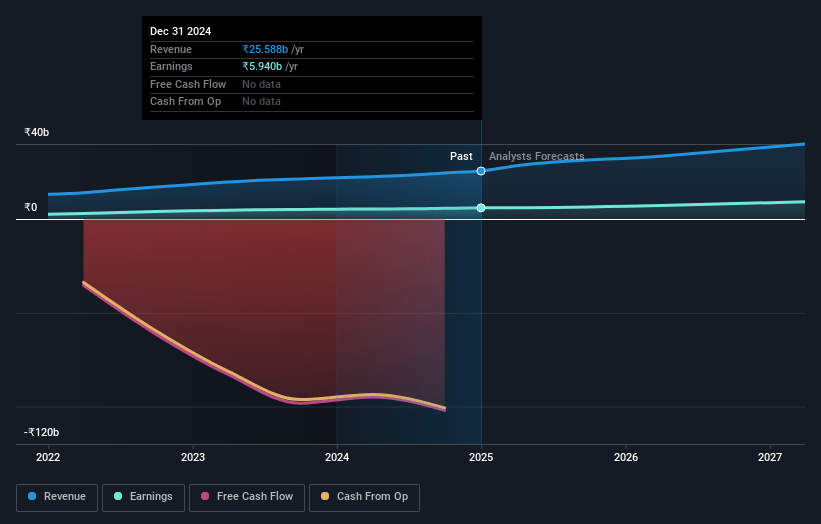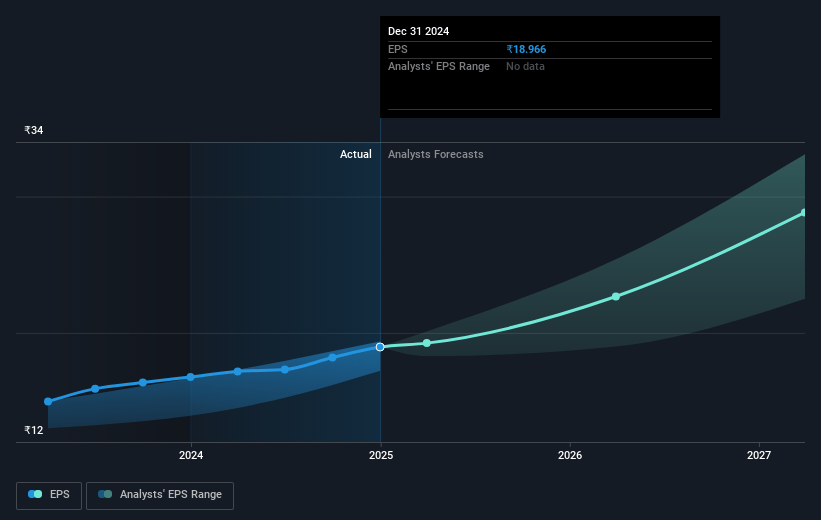Last Update01 May 25Fair value Increased 1.09%
Key Takeaways
- Strategic shifts in deposit and product mix are enhancing margins and profitability by optimizing interest rates and boosting higher-yield product yields.
- Decreased provision costs and increased fee income are improving revenue growth and profitability by reducing risk expenses and enhancing core income.
- DCB Bank faces potential earnings challenges due to reliance on rate stability, strategic shifts affecting margins, and capital raising pressures amid increased operating expenses.
Catalysts
About DCB Bank- Provides various banking and financial products and services in India.
- The technology and productivity enhancements that DCB Bank has been implementing are beginning to show positive results. This could lead to a reduction in operating expenses over time, which would improve net margins and earnings.
- The bank is focusing on reducing the cost of deposits, with an emphasis on lowering bulk term deposit rates and retail term deposit rates. This should positively impact net interest margins (NIM) and contribute to higher net interest income.
- DCB Bank is shifting its product mix toward higher-yielding products, such as loan against property (LAP) and business loans, rather than lower-yielding co-lending products, which should boost overall yield and improve profitability.
- The bank is taking steps to improve its fee income by increasing its focus on core fee-generating activities. As core fee income has been consistently increasing over the last few quarters, this could further bolster revenue growth.
- Provision costs have been decreasing, with the bank achieving a lower cost of risk. If this trend continues, it could enhance overall profitability by reducing the drag of provision expenses on earnings.
DCB Bank Future Earnings and Revenue Growth
Assumptions
How have these above catalysts been quantified?- Analysts are assuming DCB Bank's revenue will grow by 23.3% annually over the next 3 years.
- Analysts assume that profit margins will increase from 23.2% today to 24.4% in 3 years time.
- Analysts expect earnings to reach ₹12.1 billion (and earnings per share of ₹38.57) by about May 2028, up from ₹6.2 billion today. However, there is some disagreement amongst the analysts with the more bullish ones expecting earnings as high as ₹13.7 billion.
- In order for the above numbers to justify the analysts price target, the company would need to trade at a PE ratio of 6.1x on those 2028 earnings, down from 6.9x today. This future PE is lower than the current PE for the IN Banks industry at 10.7x.
- Analysts expect the number of shares outstanding to grow by 0.37% per year for the next 3 years.
- To value all of this in today's terms, we will use a discount rate of 14.01%, as per the Simply Wall St company report.
DCB Bank Future Earnings Per Share Growth
Risks
What could happen that would invalidate this narrative?- The bank's net interest margins (NIMs) have shown signs of stabilization, but there are concerns about future rate cuts by the RBI potentially impacting margins negatively if the bank cannot continue to lower its savings account rates indefinitely, potentially impacting earnings.
- The convergence of net interest income (NII) growth with loan growth is expected to experience a lag due to rate cuts, which may delay the targeted return on equity (ROE), potentially affecting the bank's revenue growth trajectory.
- The bank's strategy includes reducing co-lending growth, which has been previously a contributor, albeit with lower margins. This shift might affect overall NIMs and profitability despite aiming to replace this with higher-yielding organic products, introducing execution risk and potential revenue volatility.
- There is a looming need for capital raising to support growth ambitions, but with current share prices below book value, raising capital at this time could be dilutive to existing shareholders, adding financial and strategic risks.
- The bank's operating expenses have increased alongside branch expenses, and efforts to maintain efficient technological enhancements and employee productivity will be critical to avoiding adverse impacts on net margins.
Valuation
How have all the factors above been brought together to estimate a fair value?- The analysts have a consensus price target of ₹157.333 for DCB Bank based on their expectations of its future earnings growth, profit margins and other risk factors. However, there is a degree of disagreement amongst analysts, with the most bullish reporting a price target of ₹178.0, and the most bearish reporting a price target of just ₹110.0.
- In order for you to agree with the analyst's consensus, you'd need to believe that by 2028, revenues will be ₹49.7 billion, earnings will come to ₹12.1 billion, and it would be trading on a PE ratio of 6.1x, assuming you use a discount rate of 14.0%.
- Given the current share price of ₹135.16, the analyst price target of ₹157.33 is 14.1% higher.
- We always encourage you to reach your own conclusions though. So sense check these analyst numbers against your own assumptions and expectations based on your understanding of the business and what you believe is probable.
How well do narratives help inform your perspective?
Disclaimer
AnalystConsensusTarget is a tool utilizing a Large Language Model (LLM) that ingests data on consensus price targets, forecasted revenue and earnings figures, as well as the transcripts of earnings calls to produce qualitative analysis. The narratives produced by AnalystConsensusTarget are general in nature and are based solely on analyst data and publicly-available material published by the respective companies. These scenarios are not indicative of the company's future performance and are exploratory in nature. Simply Wall St has no position in the company(s) mentioned. Simply Wall St may provide the securities issuer or related entities with website advertising services for a fee, on an arm's length basis. These relationships have no impact on the way we conduct our business, the content we host, or how our content is served to users. The price targets and estimates used are consensus data, and do not constitute a recommendation to buy or sell any stock, and they do not take account of your objectives, or your financial situation. Note that AnalystConsensusTarget's analysis may not factor in the latest price-sensitive company announcements or qualitative material.











